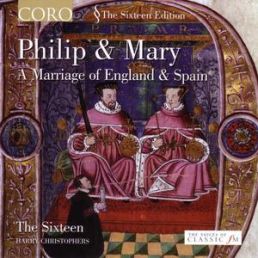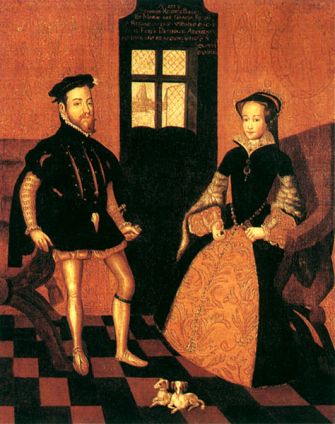In 1553 the young King Edward VI died, the succession of the country, still mainly catholic, fell on the oldest sister of the king, Lady Mary Tudor who had been re-instated into the succession in 1544. Mary was crowned queen regnant as Mary I of England on 1 October 1553.
At age 37, Mary turned her attention to finding a husband and producing an heir, thus preventing the Protestant Elizabeth (still her successor under the terms of Henry VIII's will and the Act of Succession of 1544), from succeeding to the throne. Her cousins, Edward Courtenay, 1st Earl of Devon [a great-grandson of Edward IV of England] and Cardinal Reginald Pole [grandson of George Plantagenet, 1st Duke of Clarence, brother of Edward IV] were both mentioned as prospective suitors, but her cousin Charles V suggested she marry his only son, the Infanta Philip of Spain [later Philip II]. Philip had a son from a previous marriage and was heir apparent to vast territories in Continental Europe and the New World. As part of the marriage negotiations, a portrait of Philip by Titian was sent to her in September 1553.
Charles V suggested that it was married Philip. It was the providential chance to create an alliance Anglia-Spaniard against France. In August of 1553, when Simon Renard, ambassador, approached the question for the first time indirectly with Mary: “she started to laugh not one, but some times, and looked at for me as that to say that she very found the subject of its affability”. When the marriage seemed a possibility, Charles entered in contact with Philip that immediately placed in disposal. When Charles made a proposal formal on behalf of he's son, the nervous reply of Mary quickly changed itself into active interest. bombing Renard with curious questions on the prince, she asked for a picture of the future husband.Then a copy of the splendid picture was sent that Titian makes of Philip in armor. Since the start Mary left well clearly what she waited and what did not wait of that marriage:
" if Philip will be inclined to be loving, this is not my desire, therefore I am in the age that he's highness already knows, and never I fed love thought. But if he to desire to interfere in the government of my country, could not allow such thing”. Said the queen to Renard. In 29 of October in its particular chapel and only with the presence of its lady of company and Renard, Mary swore to accept Philip as he's husband.
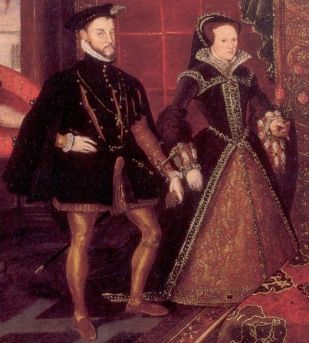
Philip accepted the marriage with Mary considering only one scheme politician, he was not enthusiastic with the idea, but the desire of the father was accepted. In England had one strong opposition to the marriage, in all the levels, fomented diligently for French ambassador Noailles. Although the English and Spaniard had been allies for much time, the first ones did not accept to be dragged for the wars of Charles V and distrusted of the problems generated for the presence of the protestantism in he's country.
The majority of the real council did not approve the marriage, in 31 of October the house of commons requested the queen to did not marry an foreigner. With typical Tudor determination , Mary insisted. In 16 of November she convoked a fast meeting of the common ones and announced the decision. The contract of marriage, signed in 12 of January of 1554, tried to calm the English fears. Philip would share responsibilities and headings with Mary, would obey all the laws and English customs, would not admit foreigners as employee in England and would not involve the same one in wars.
If Mary died before, he would leave he's powers; the conditions were very similar the ones that the governing of Spain were accustomed (as the one that the grandmothers of Mary and greats-grandmother of Philip had accepted at the time of their marriage.) So he did not have any problem in accepted them.
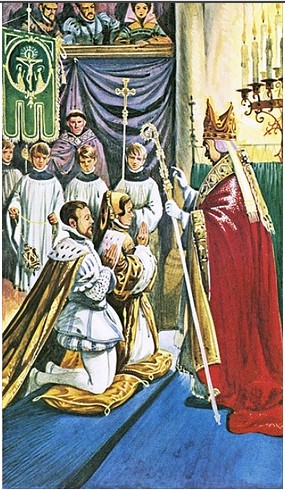
Frustrated because of the success of Charles in arranging the marriage, Henry II of France conspired with the English noblemen grumblers, sending to them money through Noailles. In January of 1554 the leader of the council, the bishop Gardiner , published orders for the capture of the main conspirators. The only part of the conspiracy that really arrived to be a rebellion was the movement of Kent for Thomas Wyatt's son. The rebels had marched on London, but Mary resisted and in a speech in guildhall in 1° of February she called the population in her assist directly. As in the start of the reign the tolerance with the conspirators it are considered one of the causes of 1554 rebellion, the clemency was abandoned. About fifty people they had received the sentence from death, including the innocent Lady Jane Grey. Meanwhile English ambassadors had been Spain to escort Philip until England, as the prince repayment ordered England the traditional gift, a marriage jewel that was taken by it marks of wools navas.
He left in ship at La Corunna in the afternoon of 13 of July, the fleet understood seventy great ships and some minors, who took the lords and the ladies most important of Castile, as well as a force of 4.000 soldiers.
The Spaniards had been received by the typically English climate, winds and a strong rain that did not cease per some days. The queen, offered Philip with the admission in the order of jateirra, association of the cavalry medieval. In the following day the fleet after disembarked the prince two days of rest followed for London. “mounted in a white horse, dressing an embroidered sumptuous coat in gold, with a white penalty in the hat, Philip was received in the cathedral for the chancellor, Stephen Gardiner, He spoke in Spaniard and it in French with the queen, since daughter of Katherine of Aragon, the infant of Spain, she understood well the language , after talking for half hour they had kissed themselves and left.
In the night of thursday, the prince and the queen had received the visit from the personal emissary of Charles, Juan de Figueroa, regent of Naples,he brought a very special wedding present: the formal investiture as king of Naples and duke of Milan. Charles, with effect, had abdicated of these lands passing them for he's son. The real couple agreed immediately that the heading of king of Naples would have to be granted publishes formal and, before the ceremony of the marriage to the cathedral to the following day. Philip was now king for he's proper right and could be married the queen of England in equality foot. It already signed letters as “El Rey-prince”.
The marriage happened with the appropriate splendour in the cathedral of Winchester in 25th July, Philip instructed he's people that they adjusted to the customs “that all we have that to accept as ours”. Although sufficiently conscientious of the recent rebellion and the lack of security, it existed in England reduced the size of its escort in the country and included English noblemen in its comitiva. “He tried to say English, in an occasion when saying farewell itself to the queen in he's first meeting, already he was late and taught to say `to it good night”, but he forgot in one minute and had that to come back toward asking another time to her. People walked in the way it, although rain and treated the ladies graceful. He also drank the tepid beer of the English, for does not offend them. An ambassador commented who “demonstrated to such sweet of temperament that it would be impossible to surpass them”.
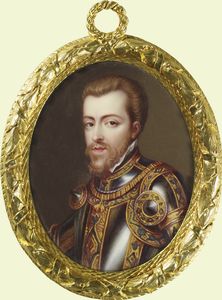 Henry Pierce Bone (1779–1855) Philip II, King of Spain (1527-98) 1844 Enamel on gold6.8 × 5.4 cmPurchased by Queen Victoria from the artist in 1844Signed, dated and inscribed on the counter-enamel: Philip 2nd of Spain/ London Jany. 1844. Painted/ by Henry Pierce Bone/ Enamel Painter to Her/ Majesty & H.R.H. Prince/ Albert &c. Original/ by Titian Henry Pierce Bone (1779–1855) Philip II, King of Spain (1527-98) 1844 Enamel on gold6.8 × 5.4 cmPurchased by Queen Victoria from the artist in 1844Signed, dated and inscribed on the counter-enamel: Philip 2nd of Spain/ London Jany. 1844. Painted/ by Henry Pierce Bone/ Enamel Painter to Her/ Majesty & H.R.H. Prince/ Albert &c. Original/ by Titian | Philip reported in a letter to his sister Juana, that "after the wedding we went to London where he was received with demonstrations of affection and general joy . The royal couple went down the Thames by boat and made their entrance by the river on August 18th, sailing under the bridge at Westminster and landed in the heart of the city. After staying in London six or seven days, they spent what remained of the summer at Hampton Court. In September already begun to deal with the affairs of the kingdom. A large number of notables were in the royal court, Gonzalo Perez estimated about eighteen different languages.
In addition to the wonders of the legend of King Arthur and the landscape, however there was little to delight them, they thought the English whites, pinks and bullies. All the celebrations were to eat and drink beer there was tension and hostility. "We are in good land, but between one of the worst people in the world." In London there were several incidents in the street, and often the Spaniards were attacked and robbed. They found the ladies of the court "pretty ugly". "A" noble disappointed commented: "I do not know why I was outside the palace saw some very beautiful women." The belief that the Spaniards had to Mary was unequivocal: "The Queen is not pretty, not at all, is low, fragile structure instead of fat, with very white hair and blond, has no eyebrows, is holy, she dresses very badly.
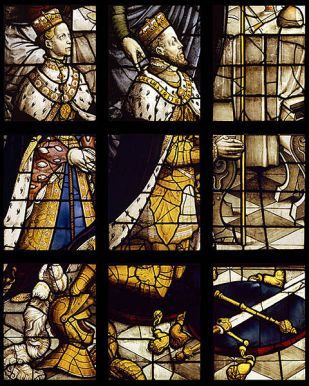
The Queen was sincere and dedicated in their relations with Philip while he was generous and cuts to her. Both sides had accepted that love was not part of the contract. Ruy Gómez noted tactfully that "The Queen is a lady of quality, but older than we thought, but his Highness is behaving so well and gives so many gifts that I'm sure both will be very pleased with each other, the king is trying to be as friendly as possible, he believes that his marriage was not made for flesh, but for the restoration of this area and preservation of those states (Flanders). In the months after the wedding, Philip refrained from interfering in government of England, and thoroughly devoted himself to politics in Spain, Italy and America.
Philip contributed substantially to the agreement of religion, on November 30 he and Mary presided over a joint session of parliament traveling in which reconciliation with Rome after twenty years of division had been legalized.
For his father, who wanted to see him, he replied: "I greatly desire to kiss his hands and see him talk to you, I beg you once more to accept that when this is over I can go further, the queen is pregnant, later will be easier and I think it will be more or less in January, "He was not as some have supposed, eager to escape England and Mary."
However, in England the religious agreement was deteriorating in a tragic way at the end of 1554, a group of Episcopalians cuts initiated the proceedings against heresy select persons on February 1, 1555 the first victim of persecution was ordered to death by fire. Many European observers in London by his experience, believed that the fire was not the solution, were horrified, on February 5, Simon Renard wrote an urgent letter to Philip, "I do not think it's good that Her Majesty allowed to occur more executions "the king, but had no power to intervene in the courts of the church, he approached the problem differently, the following Sunday, his confessor Friar Alfonso de Castro before the court preached a sermon that denounced the burning of men, saying simply that they had learned in scripture to burn anybody for reasons of conscience, but rather that they should live and be converted.
The first response of Philip to the problem of persecution was moderate, he agreed with the sermon of Castro, but several Spanish clerics supported the British bishops and their persecution. The opinion of Mary herself that "punishment should be with no cruelty" was not translated into a policy of moderation.
The persecution and the rumors of the Spanish Inquisition being introduced in England continued to plant a new seed of xenophobia. The Venetian ambassador commented that Philip was not only popular but also would be more if he could drop the Spaniards of them.The presence of the king lasted a little over a year, he intended to cross the continent to go to Brussels in the spring to confer the emperor, but was prevented by the suspicion that Mary was pregnant, but it was a false alarm.
Once all were reconciled with reality, Philip hastened his departure. Most of the court remained in London when he took leave of the queen at Greenwich on 28 August. Mary was comforted, although it contained the tears at the time of departure, Philip in turn had fun kissing all the ladies. His group left in barges down the river and the queen returned to her chamber, she gave vent to all their sorrow, with a flood of tears if not left the window once while he was in sight.
While Philip was increasingly involved with the war against France, England was not spared. Mary was managing the England, Pole and the restoration of Rome in the church, contained messages were sent to the king, urging him to return to their services, she needed support, especially after the death of the Bishop of Winchester. In February 1557 he sent Ruy Gomes back to Spain to see that money was available for the war. Now it was also important to help the British. The country entered the war and lost Calais leaving the people revolted and the Queen desolate.
When he learned of the death of his father, Philip left for Brussels, and unexpectedly learned of the death of his wife, Mary Tudor I of England had died. Sent instructions ordering the rituals for the Queen in Savoy, in his absence and in Brussels for the emperor.
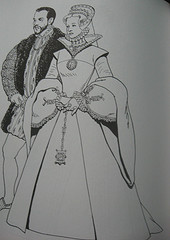
|
